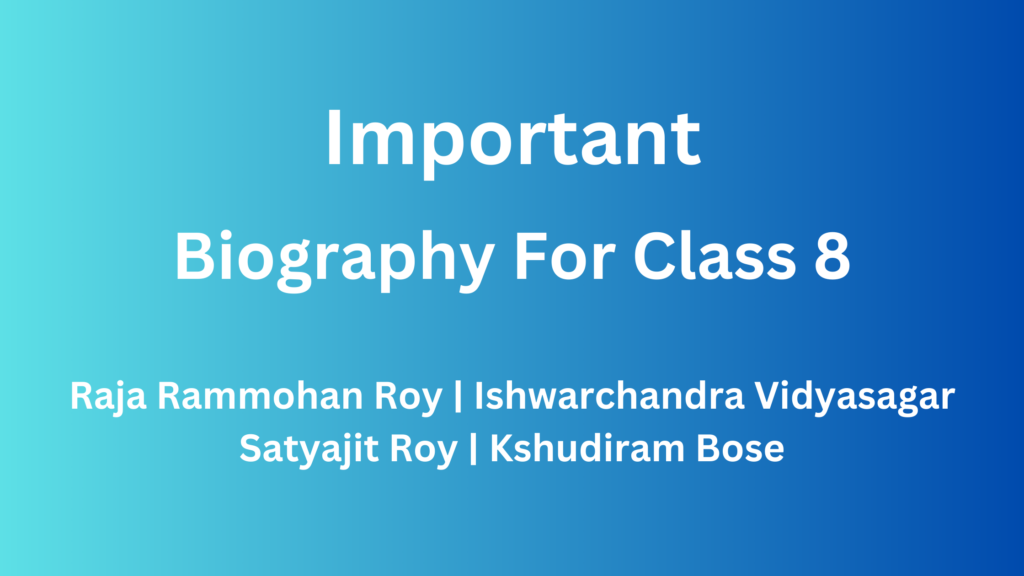
Biography writing:
1) Raja Rammohan Roy
Raja Rammohan Roy, the pioneer of modern India, was born at Radhanagar in Hooghly on 22 May 1772. He was educated in Sanskrit, Arabic and various foreign languages apart from English. As a religious and social reformer, he revolted against idolatry and laid the stepstone of the Brahmo Samaj. He also protested against the evil social customs of his time such as casteism, early marriage etc. He was a humanist who criticize the ‘Sati‘ system and was successful in abolishing this inhuman practice. Rammohan Roy wished to separate the benefits of western culture and modern education among the Indians.in fact he was the torch-bearer of Renaissance in India. He died in Bristol on 27 September 1833. His contribution in the protest of modern India is unforgettable.
Also read: Short Biographies for Class – 7 | English Biography
2) Ishwarchandra Vidyasagar
Pandit Ishwarchandra Vidyasagar, was born to Thakurdas Bandyopadhyay and Bhagabati Devi on 26 September 1820 at Birsingha, Medinipur. In his boyhood he had to struggle against poverty and was educated in a village pathsala. Later, he was admitted to the Sanskrit College in Kolkata. Here he earned the title of ‘Vidyasagar‘. He became the ‘Head Pandit‘ in Fort William College and the Principal of Samskrit College. He also served as the Inspector of Schools. Vidyasagar was famous for his simple living, high thinking and benevolence. He pioneered the spread of woman’s education. He wrote Barna Parichaya, Bodhodaya, Sitar Banabas, Kathamala, etc. for the development of Bengali language and literature. He also influenced the British government to pass the Hindu widow Remarriage Act. He died on 29 July 1891. We pay our heartiest homage to this great son of Bengal.
3) Satyajit Roy
Satyajit Roy, the eminent film director was born on 2 May 1921 to Sukumar Ray, a famous poet in Juvenile literature and Suprabha Devi. The nicknamed Manik, he was a versatile genius and directed many memorable films. ‘Pather Panchali’, his most celebrated work was released in 1955. It was awarded the President’s gold medal and twelve other international awards. The other two of the trilogy – ‘Aparajita’ and ‘ Apur Sansar’ were released in 1956 and 1959 respectively. This was followed by ‘Mahanagar’, ‘Charulata’, ‘Ashani Sanket ‘ and ‘Sonar Kella‘ and finally ‘Agantuk’ in 1991. Feluda and Professor Shanku are his most famous literary works. The prestigious ‘Oscar’ was awarded to him by the Academy of Motion Pictures, U S.A in 1992. He obtained ‘Bharat Ratna‘ just before his death on 23 April 1992. We pay our heartiest homage to this world famous artist.
4) Kshudiram Bose – The Great Martyr
The great Martyr, Kshudiram Bose, was born at Habibpur in Medinipur district on 3 December 1889. His father Trailokyanath Bose was an employee of Narajol Raj Estate. His mother LaxmiPriya Devi died early. He was brought up by his sister Aparupa Devi in Tamluk. He completed his early education at Hamilton School. In 1904 he was admitted to Medinipur Collegiate school in class VII. His urge for freedom flourished here and in 1905 he became a member of the Revolutionary Group. In 1908, he went to Muzaffarpur with Prafulla Chaki to assassinate Mr Kingsford, on 30 April he hurled a bomb at the coach of Mr Kingsford. The British Police arrested him on 1 May and he was sentenced to death on 13 June. On 11 August 1908, Kshudiram Bose stepped to the scaffold with a smile on his face. He remains alive in the hearts of millions as the spirited martyr of Bengal.